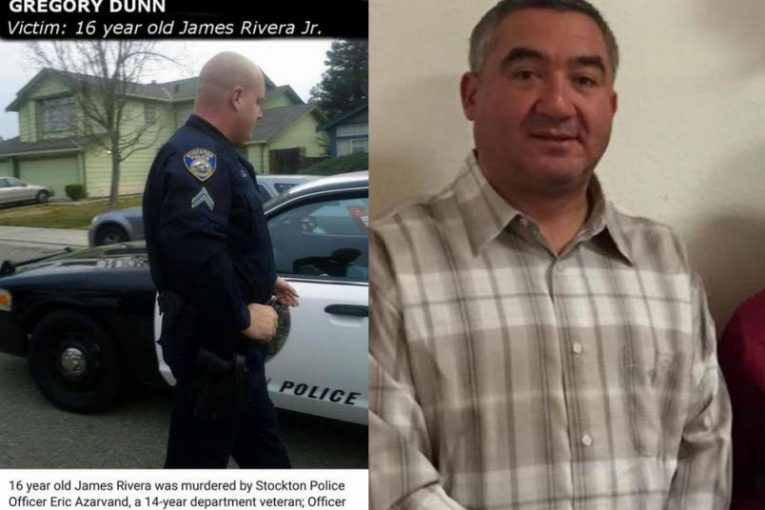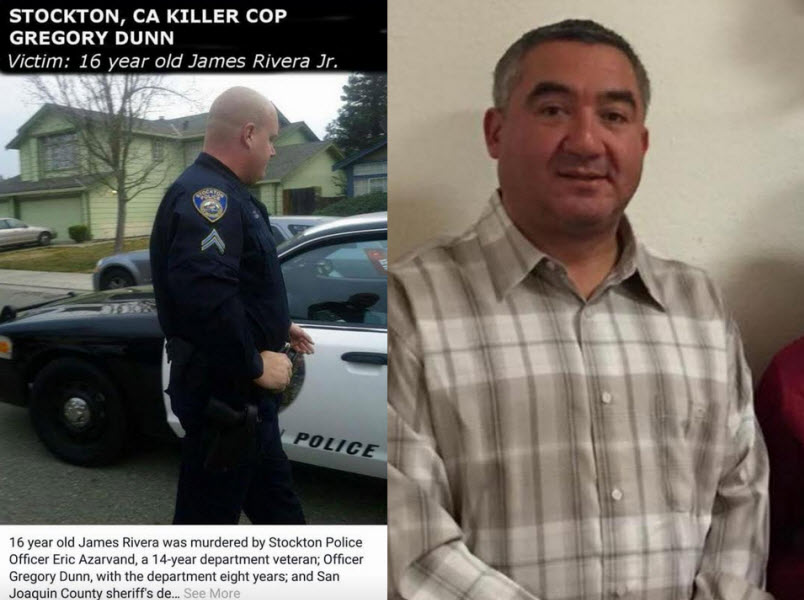

By Crescenzo Vellucci
Vanguard Capitol Bureau
SACRAMENTO – The mother of a 16-year-old special needs son shared a U.S. District Court courtroom witness stand Tuesday with two of the police officers who killed her son nearly 10 years ago.
The heartbroken mother spent much of her time fighting back tears – not always successfully – while the trained officers were more surgical and more rehearsed on the stand.
The officers and the city of Stockton are being sued for millions of dollars in damages. And Tuesday was the second day of the trial – in what is anticipated to be a two-week long federal civil trial with about 30 witnesses expected to be called.
Dionne Smith-Downs, the mother of James Rivera, Jr., is expected to continue testimony first thing Wednesday morning in the courtroom of U.S. Magistrate Judge Carolyn K. Delaney, but her hour or so of testimony Tuesday was an emotional roller-coaster.
That compared to the largely nothing-but-the-facts testimony earlier Tuesday from the two defendants – Stockton Police officer Eric Azarvand and former Stockton officer Greg Dunn, who killed Rivera in a hail of bullets in July 2010 as he sat in the driver’s seat of a stolen van in a darkened triplex garage.
Smith-Downs and James Rivera, Sr., parents of the teen, are seeking $10 million in general damages against the city of Stockton. And, they said they want “justice.”
The trial was delayed for years as Stockton finalized its bankruptcy.
Smith-Downs told the jury Tuesday that her son was diagnosed with “mild mental retardation” at an early age, and that she guided him through a special program and schools for years, before he began to “get into trouble” when he was about 14 because he started running around with the “wrong crowd.”
to “get into trouble” when he was about 14 because he started running around with the “wrong crowd.”
Smith-Downs, between tears, said she sent her son to live with her brother in another part of town to try to separate him from those “wrong” friends.
“I didn’t just give him away. I saw him all the time. But I wanted to keep him out of trouble,” said the mother of 14. “I did my best. I love him till death, and I want to get him justice – that’s why I’m here today,” she added.
Rivera escaped from juvenile hall with another teen earlier in 2010, and Smith-Downs blames those officials for part of her son’s escalating troubles, noting she was “very upset” her son was not allowed back in because he injured his leg when he was escaping.
Rivera Jr.’s birthday was the day after he was killed, and his mother said the teen was excited, asking her to “do it big” and insisting she order a “special cake.”
But the next day, Smith-Downs was asleep when she received a phone call from a neighbor. She drove over to where officers had shot her son – Smith-Downs called it a “murder,” but the court told the jurors Tuesday to disregard it.
“I saw the yellow tape and police, and my son being put in an ambulance,” she said. Smith-Downs followed the ambulance to the hospital, explaining that “I’ve been in his life every day of his life. He didn’t deserve to die like this.”
Earlier Tuesday, defendant Azarvand, now a Stockton police detective, described the shooting scene as “traumatic.”
He was intensely questioned about whether he recognized Rivera when he drove by him just before the shooting. Some of his comments at a police office evaluation after the shooting and a subsequent deposition contradicted each other, charged lawyers for the plaintiffs.
Attorney Ben Nisenbaum of the John Burris civil rights law firm sought to impeach Azarvand’s testimony, noting that one report had him stating he “locked eyes” with Rivera, but he also said he couldn’t tell if it was Rivera because he had something “like a hood” covering his face.
Azarvand confessed that he actually was “familiar” with Rivera Jr., who had stolen a golf cart, said Azarvand earlier. The youth was accused by Azarvand with assault with a deadly weapon for driving the cart toward his car at a speed of about 10-15 miles-per-hour earlier in 2010. No charges were filed.
But Azarvand took on a heavy line of questioning when he maintained he feared for Dunn’s life because the van – stuck in the garage – appeared to back up and bump Dunn’s patrol car, parked right behind it.
“I saw the reverse backup light. Officer Dunn was trapped. I was focused on the threat to him and the public,” the officer-now-detective testified. He added that Rivera had “shallow” breathing after they pulled him out of the van, despite Rivera taking nine shots to his body.
Under intense questioning by Nisenbaum, Azarvand admitted that he never saw a weapon in Rivera’s possession or in the van. He did insist that the disabled van with flat tires was a weapon, noting “vehicles with flat tires can move just as well as vehicles with tires.”
Then it was Dunn’s time to testify – the former police officer now owns a sand-blasting company. He was an officer from 2002 to 2015.
Dunn said he made a “conscious” decision to “forget” about the incident and his role more than nine years ago. He said the years since the killing have been “challenging” to him – he said he’s been diagnosed with Post Traumatic Stress Disorder (PTSD), and that he has “images I can’t get out of my mind.”
Dunn emptied 13 rounds into the garage that day in 2010. Azarvand fired three times.
Dunn insisted he rammed Rivera’s van twice, and fired into the garage to “protect” people in the area who had come out to see what police were doing that day. Dunn said he tried to ram Rivera’s van head-on to stop him.
After Dunn hit the vehicle a second time, causing it to run over a community mailbox and become wedged into a triplex garage, Dunn said drove his police vehicle up behind the van to pin it to the garage.
“I just wanted to make sure he didn’t get out…couldn’t escape. I had tunnel vision,” Dunn said, who emphasized that he “expected to get shot or run over.” That didn’t happen, but Rivera, said Dunn, “never gave up, never put his hands up.”
Dunn, like Azarvand, said his chief fear was the van was about to get away, that he saw “clumps of dirt” and other debris coming up from spinning tires. When reminded by Nisenbaum that the van was stuck, and the wheels just spinning, Dunn still said that it was the “scariest thing of my life. I started fearing I had no other options (but to fire). My concern was not dying.”
And even when the 29 rounds pounded the van, breaking out the windows, Dunn said he still feared Rivera had a gun. It was only when other officers pulled the limp Rivera out of the vehicle did Dunn say he felt safe.
“I could see him slumped down to the side. He was dead weight. I looked away; I didn’t want to see. I wish he would have given up, showed us his hands,” said Dunn, adding that it has been “a challenging nine years. I’m still learning details. Time has slowed so much. Your brain doesn’t…protect you.”
Plaintiff witness Christopher Young, called earlier Tuesday to the stand, seemed to contradict much of what Azarvand and Dunn said, based on Young’s observations as a triplex neighbor of the resident whose garage was smashed into by Rivera.
Young said the van wasn’t going fast – Dunn claimed it was speeding. Young also described Dunn’s vehicle a performing a “pit maneuver” when it rammed the van twice, eventually causing it to crash into the garage.
“I was shocked at what was going on…they hit the back of the car…to make him crash,” said Young, who said the car was going “maybe 10 miles per hour” because the tires were flat.
The incident “messed with me for a while. I remember it,” said Young, adding that he saw officers with handguns and an “M-16” – later confirmed by Azarvand, who never fired it because the magazine failed.
But most importantly to the plaintiff’s case, Young said that “the van never moved,” and that it was never a threat to injure officers or residents, a claim made by the officers and a reason for them to open fire on unarmed Rivera.
Young’s testimony was supported by Dorothy Wyatt, who also said the van didn’t move and that police “just began shooting into the garage…they just drove up and started shooting, like in a movie.”
Wyatt also said she didn’t hear the police warnings, and that she had to jump out of the way from her position on the lawn next to the garage as a police car rolled up to the scene and the officer inside also began shooting.





